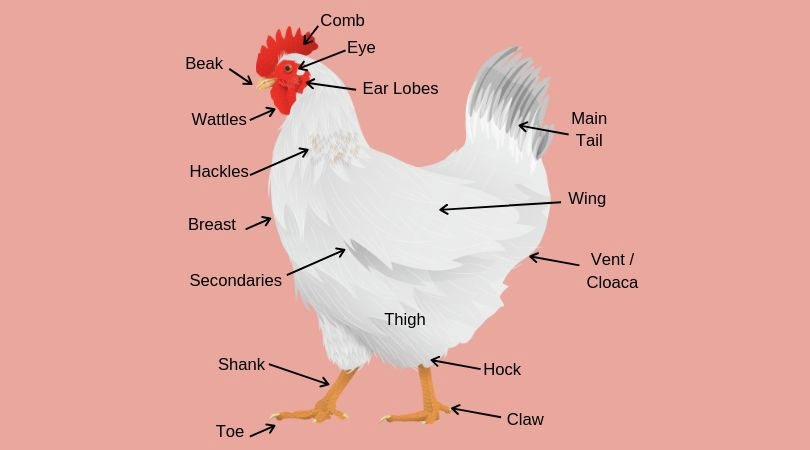The chicken back, also sometimes referred to as the chicken’s backbone or back portion, is an often overlooked and underutilized cut of poultry. Despite its lack of notoriety, the chicken back is actually a versatile ingredient packed with culinary potential
Anatomy of the Chicken Back
To understand the chicken back, it helps to visualize how it fits into the anatomy of a whole chicken. Technically speaking, the chicken back consists of the entire rear section of the backbone along with the attached ribs and residual meat.
It extends from the neck region down through the back and ends at the hip area. The chicken back is what remains after the more commercially prized cuts like the breast wings thighs and drumsticks have been removed.
Key features of the chicken back include:
-
Backbone – the spine or spinal column of the chicken.
-
Ribs – the rib bones extending from either side of the backbone.
-
Residual meat – relatively small amounts of muscle, fat and connective tissue attached to the bones.
-
Oyster meat – two small, tender muscles on either side of the backbone.
Culinary Uses for the Chicken Back
Given its bony structure, the chicken back is not ideal for dishes where bone-in cuts are undesirable. You won’t often see chicken backs baked, grilled or pan-fried as an entree.
However, the chicken back truly shines when used to impart flavor and body to stocks, broths and braised dishes. Let’s explore some of its best culinary applications:
Making Stock
Chicken backs are a secret weapon for elevating the flavor of homemade stocks and broths. Simmering chicken backs releases gelatin, collagen and nutrients from the bones, cartilage and marrow. This transforms an ordinary stock into a rich, mouth-coating liquid gold.
For the deepest flavor, roast the chicken backs before simmering to develop richer, more complex flavors. Aromatics like onions, carrots and celery complement the chicken essence.
Braising and Stewing
The chicken back’s high collagen content makes it ideal for moist heat cooking methods like braising and stewing. While the meat alone would be dry and lean, the collagen melts into the surrounding liquid, resulting in succulent, fall-off-the-bone texture.
Chicken backs contribute incredible richness, body and flavor to dishes like chicken stew, gumbo and pozole.
Adding to Ground Meat
Pre-cooked chicken back meat provides an economical way to stretch ground meats while adding moisture and flavor. Shredded chicken back meat seamlessly blends into burgers, meatballs, meatloaf and more. For best results, remove any bones or cartilage before mixing into ground meat.
Pet Food Supplement
Raw chicken backs offer a nutrient-dense supplement for dogs or cats on a raw diet. Always consult your veterinarian before introducing. The bones provide calcium while the cartilage offers joint supporting properties. Only feed properly thawed, fresh chicken backs.
Rendering Schmaltz
Rendering or cooking chicken backs yields schmaltz, a treasured traditional Jewish ingredient. Schmaltz is clarified chicken fat with an unmistakable rich, meaty flavor. Roasting the chicken backs separates the fat from the meat and bones. Schmaltz finds use in everything from matzo ball soup to fried latkes.
As you can see, humble chicken backs unlock an amazing array of culinary possibilities. Their high collagen content allows you to create rich, nourishing dishes destined to become new family favorites.
Buying and Storing Chicken Backs
Now that you’re convinced of the chicken back’s merits, let’s explore the best practices for sourcing and storing them:
-
Butchers – Ask your local butcher if they have chicken backs available. Butchers often accumulate chicken backs and are happy to sell them at a discounted price.
-
Grocery Stores – Check the frozen meat section of grocery stores with in-house butchering. Chicken backs are sometimes available frozen in bulk.
-
Farmers Markets – Ask vendors at farmers markets if they can source high-quality chicken backs from pasture-raised birds.
-
Refrigeration – Fresh chicken backs will last 1-2 days in the fridge. Rinse under cold water and pat dry before refrigerating.
-
Freezing – For longer storage, freeze chicken backs in airtight bags with the air pressed out. They’ll keep for 4-6 months in the freezer.
-
Thawing – Always thaw frozen chicken backs overnight in the refrigerator. Never thaw them at room temperature.
Following proper handling procedures ensures you get the most out of these economical cuts.
Frequently Asked Questions About Chicken Backs
Let’s review some common questions about working with chicken backs:
-
Are chicken backs safe to eat on their own? No, chicken backs contain small, porous bones not suitable for direct consumption. They’re best used in stocks or stews where the bones cook down.
-
How much meat is on a chicken back? Chicken backs contain relatively little meat – often less than 20% of their total weight. The bones, fat and cartilage dominate.
-
What’s the difference between chicken back stock and chicken bone broth? Stock is simmered for 2-4 hours, resulting in a lighter broth. Bone broth simmers for 12-24 hours, extracting more collagen and gelatin.
-
How many chicken backs for stock? For rich flavor, plan on 1.5-2 pounds chicken backs per gallon of water. Adjust amounts based on your taste preferences.
-
Can chicken backs be reused? Yes, you can make a second batch of stock using the same chicken backs. The second batch will have a lighter flavor.
-
What are some recipes using chicken back stock? Soups, braised meats, risotto, gravy, and grains all benefit from the rich flavor and body of chicken back stock.
Conclusion
While underappreciated, the humble chicken back offers an affordable, flavor-packed ingredient to amplify your cooking. With their high collagen content, chicken backs make phenomenally rich stocks and braises. Get the most from these economical cuts by sourcing fresh chicken backs from butchers or farmers markets. Follow proper storage and handling, and you’re on your way to preparing nourishing dishes that satisfy on every level.

Uncommon Chicken Cuts

While these chicken cuts are rare in foodservice, you can still find them at butcher shops or with your whole chicken. Some cultures consider these chicken parts delicacies, making them ideal for restaurants specializing in foreign cuisine. Adding one of these chicken cuts to your menu will pique the curiosity of your customers and set you apart from the competition.
- Neck: Extending from the head to the gizzard, the neck has hard-to-access meat with lots of bone and tissue. Serve it as a salty appetizer or snack, or use it in chicken stock.
- Tail: Chicken tail is a fatty piece of dark meat sometimes served with the back, legs, or thigh. It can be roasted or pan-fried and served as a delicacy, but its high fat content encourages small servings.
- Giblets: Often thrown away and wasted, giblets include the heart, gizzard, kidneys, and liver of a chicken. While the liver can be served alone, you can add other organs to gravy, stuffing, or stock for extra flavor.
- Feet: Though not popular in the US, chicken feet are a staple of many cultures worldwide. While this cut lacks meat, chicken feet contain vital proteins that can aid your body in healing and strengthening.
Types of Chicken Thigh Cuts
There are two types of chicken thigh cuts:
- Boneless Thighs: Also known as thigh fillets, boneless chicken thighs require no additional deboning before cooking and are great for stir fry or kebabs. However, they are more expensive than cutlets.
- Bone-in Thighs: Also known as thigh cutlets, bone-in chicken thighs still have the bone and skin attached to the meat. The bone creates a juicer cut of meat cheaper than a thigh fillet.
